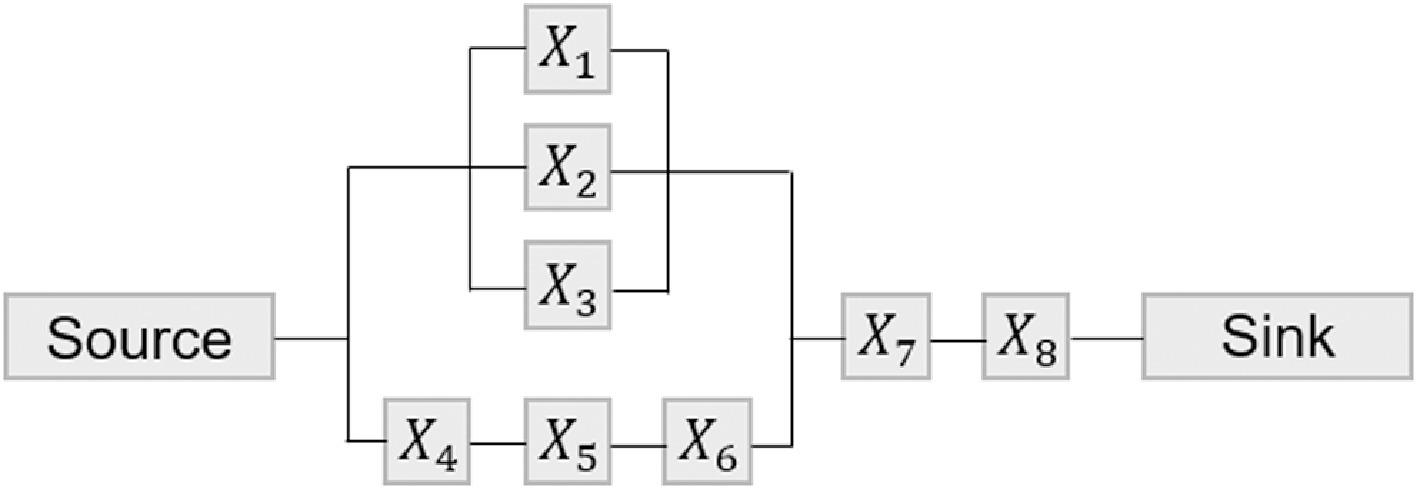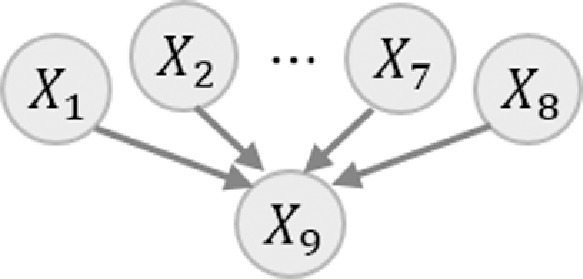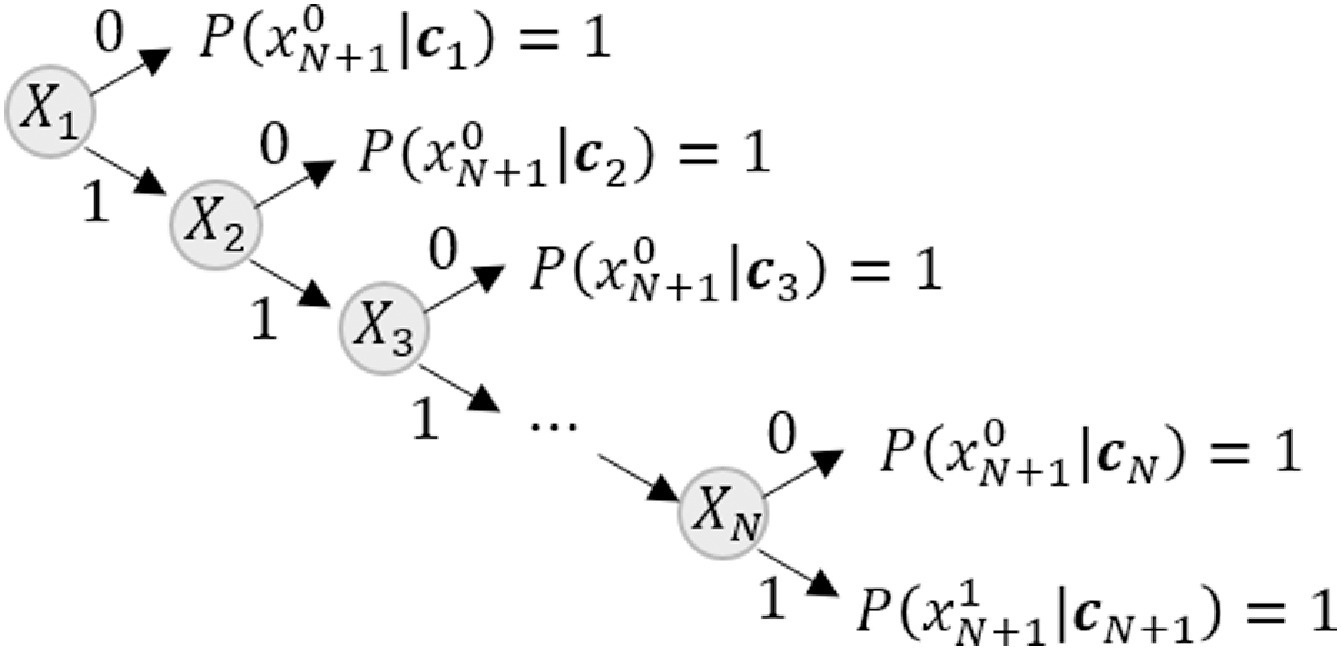Getting Started with MBNpy
This guide intorudces using MBNpy for risk/reliability analysis of system event. This guide walks through installation, defining variables and probability distributions, and performing system analysis.
Installation
MBNpy is available via pip:
pip install mbnpy
To install from source:
git clone https://github.com/jieunbyun/MBNpy.git
cd MBNpy
pip install .
MBNpy requires Python 3.12+.
Example Problem
This example demonstrates application for the reliability block diagram from the 2019 MBN paper.
The system consists of 8 components (\(X1\) to \(X8\)), each with two states:
\(0\): Failure
\(1\): Survival
Components are statistically independent with:
\(P(X_i=0) = 0.1\)
\(P(X_i=1) = 0.9\)
The system state (:math:`X_9`) depends on the connection from source to sink.

Figure 1: Reliability block diagram (RBD).
The Bayesian network (BN) representation is:

Figure 2: Bayesian network representation of the system.
Objectives
Compute the system failure probability \(P(X_9=0)\).
Identify critical components using component importance measures.
For technical details, see:
Byun et al. (2019) Matrix-based Bayesian networks, Reliability Engineering & System Safety, 185, 533-545.
Byun & Song (2021) Generalized matrix-based Bayesian networks, Reliability Engineering & System Safety, 211, 107468.
Defining Variables in MBNpy
To model a Bayesian network, variables must be defined first.
Each component is a Variable object:
from mbnpy import variable
varis = {}
varis['x1'] = variable.Variable(name='x1', values=['f', 's'])
The variable dictionary (
varis) stores all model variables."f"and"s"correspond to failure (0) and survival (1).The numerical index assigned to each state is determined by its position in the
valueslist.
All 8 components are defined using a loop:
n_comp = 8
for i in range(1, n_comp):
varis[f'x{i+1}'] = variable.Variable(name=f'x{i+1}', values=['f', 's'])
print(varis['x8']) # Check last component
The system variable (\(X_9\)) is defined similarly:
varis['x9'] = variable.Variable(name='x9', values=['f', 's'])
Defining Probability Distributions
The conditional probability matrix (CPM) represents probability distributions.
Since components (\(X_1\) to \(X_8\)) have no parents, they are defined as marginal probabilities:
from mbnpy import cpm
import numpy as np
cpms = {}
cpms['x1'] = cpm.Cpm(
variables=[varis['x1']],
no_child=1,
C=np.array([[0], [1]]),
p=np.array([0.1, 0.9])
)
variables: A list of variables involved in the distribution (e.g.,X1).no_child: The number of child nodes (1 in this case).C(Event Matrix): Specifies the state of each instance.p(Probability Vector): Defines the corresponding probabilities.
This process is repeated for all components:
for i in range(1, n_comp):
cpms[f'x{i+1}'] = cpm.Cpm(
variables=[varis[f'x{i+1}']],
no_child=1,
C=np.array([[0], [1]]),
p=np.array([0.1, 0.9])
)
The system (\(X_9\)) is defined using the branch-and-bound method:

The Csys and psys matrices are constructed:
Csys = np.array([
[0, 2, 2, 2, 2, 2, 2, 2, 0],
[0, 2, 2, 2, 2, 2, 2, 0, 1],
[1, 1, 2, 2, 2, 2, 2, 1, 1],
[1, 0, 1, 2, 2, 2, 2, 1, 1],
[1, 0, 0, 1, 2, 2, 2, 1, 1],
[0, 0, 0, 0, 0, 2, 2, 1, 1],
[0, 0, 0, 0, 1, 0, 2, 1, 1],
[0, 0, 0, 0, 1, 1, 0, 1, 1],
[1, 0, 0, 0, 1, 1, 1, 1, 1]
])
psys = np.array([[1.0] * 9]).T
cpms['x9'] = cpm.Cpm(
variables=[varis['x9'], varis['x1'], varis['x2'], varis['x3'], varis['x4'],
varis['x5'], varis['x6'], varis['x7'], varis['x8']],
no_child=1,
C=Csys,
p=psys
)
System Analysis
Variable elimination is applied to compute the system failure probability. To determine the probability distribution of the system event, all component variables except for \(X_9\) are eliminated.
from mbnpy import inference
cpm_sys = inference.variable_elim(
cpms, [varis[f'x{i+1}'] for i in range(8)]
)
print(f'System failure probability: {cpm_sys.p[0][0]:.2f}')
Component importance measures are calculated, following Kang et al. (2008)’s definition \(CIM_i = P(X_i=0|X_9=0) = P(X_i=0,X_9=0) / P(X_9=0)\):
CIMs = {}
for i in range(n_comp):
varis_elim = [varis[f'x{j+1}'] for j in range(n_comp) if j != i]
cpm_sys_xi = inference.variable_elim(cpms, varis_elim)
prob_s0_x0 = cpm_sys_xi.get_prob([f'x{i+1}', 'x9'], [0,0])
CIMs[f'x{i+1}'] = prob_s0_x0 / cpm_sys.p[0][0]
print(CIMs)